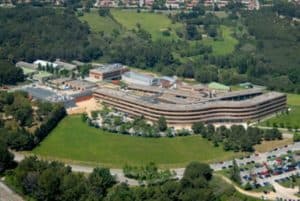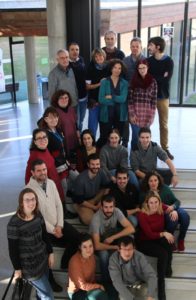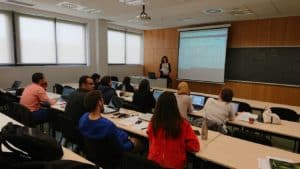As part of our committment to education, AMTS has an Academic Initiative which exposes students to and teaches students ration formulation using commercially available and fully functional ration formulation software. Ou program is used globally and we work with universities and teaching institutions around the world. We are delighted to partner with Professor Sergio Calsamiglia Blancafort at the Autonomous University of Barcelona in Spain where he uses AMTS.Pro to teach a specialized course on dairy and beef ration formulation. He wrote the following article for our blog explaining his program and his use of the software.
Using the AMTS system to teach cattle nutrition physiology and diet formulation
By Sergio Calsamiglia
Professor
Dept Animal and Food Sciences
Animal Nutrition and Welfare Service (SNiBA)
Universitat Autonoma de Barcelona
08193-Bellaterra (Spain)
The Univeristat Autonoma de Barcelona (UAB)

The Universitat Autonoma de Barcelona was founded in 1968 and has recently celebrated its 50th anniversary. In 2009, the UAB received recognition as a Campus of International Excellence for its project “UAB Campus of International Excellence: promoting knowledge, encouraging innovation”, an ambitious strategic plan to transform the UAB and its surroundings into one of the most important scientific and technological poles of the Mediterranean. Currently, the UAB has about 3,850 research and teaching staff, 26,000 students in University degrees and an additional 5000 students in the PhD programs.
In recent years, the UAB has been recognised for its efforts in promoting quality in teaching, attracting international talent and obtaining a growing impact in research, resulting in a progressive improvement in the most prestigious international rankings. Thus, the UAB is ranked the second Spanish university, occupying position 145 in the world ranking and 63 in the EU (QS World University Rankings). Up to 23 UAB degrees are included in top 5 places in their respective subjects.
Veterinary, ranked 30th among Veterinary schools in the World, 15th in the EU, and first in Spain. (Quaquarelly Symonds (QS) ranking (2019).
The school of Veterinary Medicine was created in 1982, and since then has been building mertis to become the first Veterinary School in Spain and ranked 15th within the EU and 30th in the world. Today, is among the EU Veterinary Schools that received accreditation from the European Association of Educational Veterinary Establishments. Currently, it accepts 125 veterinary students per year that are selected from about 400 applicants per year.
The School of Veterinary Science is structured in three major Departments: Veterinary Medicine, Animal Health and Animal and Food Sciences. Our research group, the Animal Nutrition and Welfare Service (SNiBA) belongs to the Department of Animal and Food Sciences.
The Animal Nutrition and Welfare Service (SNiBA)

The Animal Nutrition and Welfare Service (SNIBA, http://www.sniba.es), as part of the Department of Animal and Nutritional Science, is a well-recognized research group with sound experience in animal nutrition, production and welfare. The team consists of over 50 persons, with 8 professors, 12 Ph.D. researchers, 30 Ph.D. students and support research and laboratory technicians. Our areas of specialization are:
- Nutritional evaluation. Application of products or ingredients used in animal feed, their digestion and fermentation in the digestive tract, and the consequences of its modification of the latter.
- Quality and food safety. Nutritional impact or management of animals on the quality of the final product intended for human consumption.
- Production efficiency and animal health. Effect of changes in production conditions, feed system or feeding management on production and animal health.
- Animal welfare and behavior. Assessment of animal welfare in livestock farms, during transport and the slaughter process, animal behavior in relation to management and feeding in livestock.
- Nutrition and environment interaction. Study of the impact of nutritional and management strategies on the environment.
The SNiBA is recognized as one of the most relevant research groups in applied research in livestock science in Spain with more than five current projects funded by de Spanish Science and Innovation Ministry and numerous agreement with the Industry. The SNIBA has a combined expertise in experimental animal models, study design and data analyses to evaluate feed digestion and metabolism, gut function, animal welfare and disease dynamics. The group also has demonstrated experience in coordinating large animal studies.
In the cattle, some of the current projects involve the study of rumen modifiers (yeast, essential oils,…), mycotoxin binders and interactions with other nutrients (vitamins, minerals and amino acids), evaluation of bioavailability of rumen protected amino acids and vitamins, the value of rumen bypass proteins in dairy and beef, feeding beef cattle with limited or no forage, precision livestock management and management tools, including behavior as early predictors of diseases in cattle, the use of Big Data methods to support management decision, and the use of mathematical models to identify opportunities to improve profits in dairy farms.
This year, we have started teaching an intensive specialized course on dairy and beef cattle formulation using the AMTS program. The objective was not only to teach formulation per se, but to bring up discussion on nutritional physiology. The program was selected for its usability in field conditions, including least cost formulation, and because through the program there are a lot of topics related to digestive physiology and nutrition that come up for further discussion on nutrition.
The educational program was developed over 25 h of teaching for graduate students, and all students had to formulate at least 3 different rations in dairy and beef to obtain a certificate. At the end of the class, students had to present and defend the proposed diets in front of other students. The class was limited to 15 students, was full, and was very successful, with an overall evaluation of students of xx over 10.

This was a new and great experience, where students were confronted to real formulation problems, and they had to articulate all related issues (request analysis of forages, evaluate risks and the need for additives, etc).
Our intent, at this point, is to explore the possibilities of implementing this type of program in the undergraduate courses, although the time available will be much limited. However, we want to explore the possibility of using the program as a tool to bring up discussion in class related to the nutrition of dairy cows.
The teaching staff and all students are grateful to AMTS and the team for the opportunity to use the program and for the support during the development the class, and we hope to be able to repeat the experience in the future.
We are thankful to have the opportunity to help aspiring nutritionists gain greater understanding of beef and dairy ration formulation software and the biological principles of the CNCPS nutritional model though our Academic Initiative. If you are an educator, teaching ruminant nutrition, interested in learning more about the Academic Initiative, contact Mariann through support.
